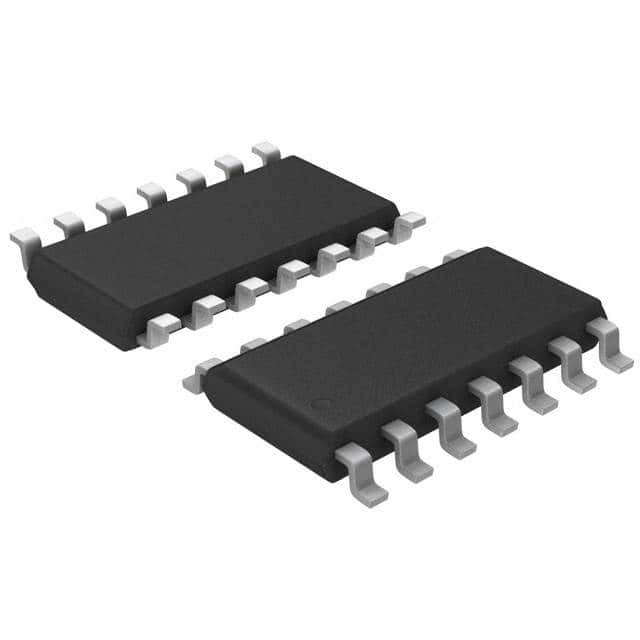Viz Specifikace pro podrobnosti o produktu.

Encyclopedia Entry: 74ACT125MTR
Product Overview
Category
The 74ACT125MTR belongs to the category of integrated circuits (ICs) and specifically falls under the family of logic gates.
Use
This IC is commonly used in digital electronics for signal buffering and level shifting applications. It provides four independent non-inverting buffers with tri-state outputs.
Characteristics
- Logic Family: ACT
- Number of Buffers: 4
- Buffer Type: Non-inverting
- Output State: Tri-state
- Supply Voltage Range: 2V to 6V
- Operating Temperature Range: -40°C to +85°C
Package
The 74ACT125MTR is available in a small outline integrated circuit (SOIC) package. This package type offers compactness and ease of integration onto printed circuit boards.
Essence
The essence of the 74ACT125MTR lies in its ability to buffer and shift logic levels, ensuring proper signal transmission between different components within a digital system.
Packaging/Quantity
The 74ACT125MTR is typically supplied in reels or tubes, containing a quantity of 2500 units per reel/tube.
Specifications
- High-Speed CMOS Technology
- Maximum Propagation Delay: 7 ns
- Maximum Input Capacitance: 3.5 pF
- Minimum Output Current: -24 mA
- Maximum Quiescent Supply Current: 8 μA
Detailed Pin Configuration
The pin configuration of the 74ACT125MTR is as follows:
┌───┐
Y1 ────│1 14│─── VCC
Y2 ────│2 13│─── Y4
GND ───│3 12│─── Y3
A1 ───│4 11│─── OE
A2 ───│5 10│─── Y3
Y1 ────│6 9│─── Y2
│7 8│─── A3
└───┘
Functional Features
- Non-inverting Buffer: The 74ACT125MTR provides four independent non-inverting buffers, allowing for signal amplification without changing the logic level.
- Tri-State Outputs: The tri-state outputs enable the buffers to be effectively disconnected from the bus, reducing the possibility of signal interference.
- High-Speed Operation: Utilizing high-speed CMOS technology, this IC offers fast propagation delay, making it suitable for time-critical applications.
Advantages and Disadvantages
Advantages
- Versatile buffering and level shifting capabilities
- Compact SOIC package for easy integration
- Wide supply voltage range allows compatibility with various systems
- Tri-state outputs minimize signal interference
Disadvantages
- Limited number of buffers (four in total)
- Not suitable for high-voltage applications (limited to 6V)
Working Principles
The 74ACT125MTR operates by receiving input signals on the A1, A2, A3 pins. These signals are then buffered and amplified by the internal circuitry. The resulting output signals appear on the corresponding Y1, Y2, Y3, and Y4 pins. The OE (Output Enable) pin controls the tri-state outputs, allowing the buffers to be enabled or disabled as needed.
Detailed Application Field Plans
The 74ACT125MTR finds application in various digital systems, including but not limited to: - Microcontrollers and microprocessors - Communication devices - Data acquisition systems - Industrial automation equipment - Automotive electronics
Detailed and Complete Alternative Models
Some alternative models that offer similar functionality to the 74ACT125MTR include: - 74HC125: High-Speed CMOS Quad Buffer with 3-State Outputs - SN74LVC125A: Low-Voltage CMOS Quad Buffer with 3-State Outputs - CD4050: Hex Non-Inverting Buffer/Converter
These alternatives can be considered based on specific requirements, such as voltage compatibility, speed, or package type.
In conclusion, the 74ACT125MTR is a versatile integrated circuit belonging to the logic gate family. Its non-inverting buffering and level shifting capabilities make it suitable for various digital applications. With its compact package and tri-state outputs, it offers advantages in terms of integration and signal integrity. However, it has limitations in terms of the number of buffers and voltage range. Understanding its specifications, pin configuration, and working principles allows for effective utilization in different application fields.
Seznam 10 běžných otázek a odpovědí souvisejících s aplikací 74ACT125MTR v technických řešeních
Sure! Here are 10 common questions and answers related to the application of 74ACT125MTR in technical solutions:
Q: What is the 74ACT125MTR? A: The 74ACT125MTR is a quad buffer/line driver IC (integrated circuit) that can be used to amplify or buffer digital signals.
Q: What is the voltage supply range for the 74ACT125MTR? A: The voltage supply range for the 74ACT125MTR is typically between 4.5V and 5.5V.
Q: Can the 74ACT125MTR handle both input and output signals? A: Yes, the 74ACT125MTR can be used for both input and output signals, making it versatile for various applications.
Q: What is the maximum operating frequency of the 74ACT125MTR? A: The maximum operating frequency of the 74ACT125MTR is typically around 200 MHz.
Q: How many buffers/line drivers are there in the 74ACT125MTR? A: The 74ACT125MTR contains four individual buffers/line drivers, allowing for multiple signal amplification or buffering.
Q: Can the 74ACT125MTR be used with different logic families? A: Yes, the 74ACT125MTR is compatible with a wide range of logic families, including TTL, CMOS, and LVTTL.
Q: What is the output current capability of the 74ACT125MTR? A: The 74ACT125MTR has a typical output current capability of 24 mA, which allows it to drive moderate loads.
Q: Is the 74ACT125MTR suitable for bidirectional data transfer? A: No, the 74ACT125MTR is a unidirectional buffer/line driver and does not support bidirectional data transfer.
Q: Can the 74ACT125MTR be used in high-speed applications? A: Yes, the 74ACT125MTR is designed for high-speed operation and can be used in applications that require fast signal propagation.
Q: What are some common applications of the 74ACT125MTR? A: The 74ACT125MTR is commonly used in digital systems, such as microcontrollers, FPGAs, memory interfaces, and communication circuits, to amplify or buffer signals and ensure reliable data transmission.
Please note that the answers provided here are general and may vary depending on specific datasheet specifications and application requirements.

